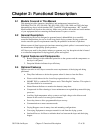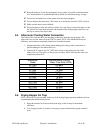
350-2100 cfm Dryers Chapter 3: Installation 18 of 58
; Keep the delivery (to the drying hopper) hose as short as possible to minimize heat
loss. Insulated hose is recommended and available for maximum energy savings.
; Do not use insulated hose on the return (from the drying hopper)
; Do not shorten the return hose. The return air to the blower must be 150°F or below.
; Make sure the hoses are not kinked.
; Drying hopper air inlet and outlet locations vary, but always connect the hoses so the
dry process air from the dryer enters the bottom of the drying hopper and flows out
the top to return to the dryer inlet.
3-5 Aftercooler Cooling Water Connection
The Aftercooler cools the moist air returning to the dryer from the drying hopper. The
aftercooler can cool the return air from 250°F to about 150°F. This maintains the dryer's
efficiency and condenses unwanted plasticizers from the airstream.
1. Support both sides of the fitting when making the cooling water connections to
prevent damage to the aftercooler coil.
2. Connect 85°F water to the 1½" NPT inlet closest to the exiting air side of the
aftercooler coil. This will cool the process air about 100°F and raise the water-out
temperature about 10°F.
Aftercooler
Model
Recommended Cooling
Water Flow Rate (GPM)
AFT350 6.6 gpm
AFT425 10 gpm
AFT500 10 gpm
AFT600 13.2 gpm
AFT700 18 gpm
AFT850 18 gpm
AFT1000 22 gpm
AFT1250 22 gpm
AFT1500 25 gpm
AFT1800 25 gpm
AFT2100 25 gpm
3-6 Drying Hopper Air Trap
ACS’s exclusive air trap assembly in the top of the drying hopper prevents ambient air from
contaminating the material being dried.
5. Keep the material level above the bottom edge of the air trap for maximum
efficiency.
6. Use a hopper loader or vacuum conveying system to maintain the proper material
level.


















